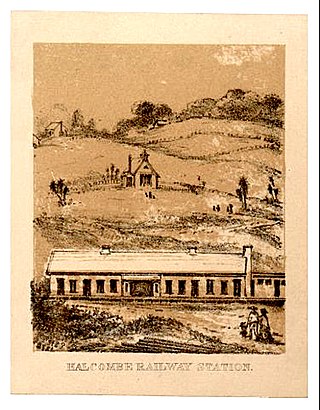Top Qs
Timeline
Chat
Perspective
Halcombe railway station
Defunct railway station in New Zealand From Wikipedia, the free encyclopedia
Remove ads
Halcombe railway station was a station on the North Island Main Trunk (NIMT) in New Zealand, serving the village of Halcombe, in the Manawatū-Whanganui region.[2][3] It opened in 1878 and closed in 1983. Originally it was the main intermediate station on the 85 mi 34 ch (137.5 km) Whanganui to Foxton railway.[4] Only a single track remains through the station site,[5] as the passing loops here and at Kakariki were replaced by the Rangitawa loop, 3.03 km (1.88 mi) to the north,[2] on 14 December 1983.[6]

Remove ads
History
Summarize
Perspective
The station had its first trains when the Feilding – Halcombe Section opened on Monday 22 April 1878.[7] When the Halcombe – Marton Section completed the railway, linking the ports of Foxton and Whanganui, on Monday 20 May 1878, the mayor of Palmerston North declared a public holiday.[8]
William Nicholson's contract for a 5th class station started on 17 January 1877 and was completed on 14 April 1877[9] for £157.5s.[10]
When it was decided that Halcombe should be the refreshment stop on the line, that original station was moved to Greatford and a much larger,[11] 104 ft (32 m) by 20 ft (6.1 m),[9] station was built[11] by J & C Bull. Their £2,845 9s 6d contract[12] got its final certificate on 23 August 1878 and was completed by 5 August 1879. To make way for expansion, the goods shed and loading bank were moved to a new site in 1881. By 1896 there was a special class station building,[9] including refreshment rooms, a kitchen, 180 ft (55 m) long passenger platform,[11] cart access to the platform, 40 ft (12 m) by 30 ft (9.1 m) goods shed, loading bank, cattle yards, stationmaster's house, urinals and a passing loop for 46 wagons. Two years later there were also sheep yards, a crane and a water service. Water tanks had been proposed in 1878, about 100 feet beyond the platform.[9] In 1910, after the NIMT opened, the need for more office accommodation was noted and a veranda[13] and longer platform were requested,[14] but rejected.[15] There was a Post Office at the station from 1895 to 1914.[9] A veranda was added in 1912[16] and was still in place in 1941.[17] Gangers houses were built in 1916 and a State house in 1955.[9]
An excursion train was derailed on the points at the station in 1902,[18] with its WD Class loco.[19][20]
Refreshment Rooms
From the start the choice of Halcombe, rather than Marton, for a refreshment stop had been criticised, by both Marton[21] and Palmerston North,[22] as had the route through Halcombe, rather than Sanson.[23] Initially the trains spent over 40 minutes at the refreshment stop,[24] but that was soon roughly halved.[25] The refreshment rooms were leased; for example, in 1883-4 the lease was £20 a year,[5] but only £12 in 1898.[26] In 1878 they were run by the Halcombe Hotel.[27] From Saturday 24 December 1898 they were replaced by rooms at Marton.[9]
Services
The line became part of the NIMT, when it fully opened in 1909, and Halcombe was one of the stopping points for Wellington to New Plymouth expresses in 1910[28] and in the 1940s.[29] In the 1920s the station was staffed by a grade 7 clerk.[30]

Halcombe had its annual returns of traffic recorded, as did Greatford to the north and Feilding to the south.[31] Passenger numbers grew initially and during the World Wars, before tailing off towards 1950, as shown in the graph and table below.
Engine shed
A large engine shed was built as part of the J & C Bull contract.[27] Nathan & Wilkie built an extra engine shed and coal store for £795.10.4 in 1878-79.[9] Initially a winch and chain was used to lift engines.[100] Another shed seems to have been added in 1894.[101]
Closure
From Saturday 6 December 1958 Halcombe was closed as an officered station. On Saturday 31 March 1962 the station building burnt down and a small storeroom was used as a temporary station. Removal of the goods shed and stockyards was approved in 1973.[9] Most of the station buildings had gone by 1974,[102] though in 1980 a station building, platform and loading bank remained. On Sunday 27 March 1983 the station closed to all traffic, but a service siding remained.[9]
Remove ads
References
Wikiwand - on
Seamless Wikipedia browsing. On steroids.
Remove ads

